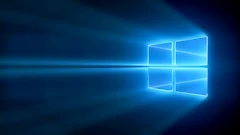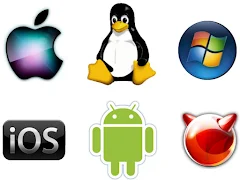Introduction to Operating Systems: Types, Functions, and Key Components
Index
Introduction
An operating system (OS) is the backbone of any computer system, managing hardware resources and providing an interface for users and applications. Acting as a bridge between hardware and software, it ensures seamless execution of tasks and facilitates communication between various system components.
What is an operating system?
At its core, an operating system is a software platform designed to control computer hardware and provide the environment needed for programs to run efficiently. It acts as a bridge between users, software, and hardware, making it possible for all three to interact seamlessly.
Without an OS, using a computer would be like trying to talk to someone who doesn’t speak your language. The operating system translates user commands into something the hardware understands and vice versa.
 ___________________________________________________________________________________
___________________________________________________________________________________
Operating systems (OS) are software platforms that manage computer hardware and provide services for running applications. They serve as an intermediary between users and the computer hardware, facilitating communication between software and hardware components.
Types of Operating Systems: There are several types of operating systems, including:
1. Desktop Operating Systems
Designed for personal computers and workstations, these OSes include:
- Windows: Known for its user-friendly interface and extensive software support.
- macOS: Popular for its sleek design and integration with Apple's ecosystem.
- Linux: An open-source OS with high customizability and stability.
2. Mobile Operating Systems
Optimized for smartphones and tablets:
- Android: The most widely used mobile OS, developed by Google.
- iOS: Exclusive to Apple devices, offering robust security and seamless app integration.
3. Server Operating Systems
Built for managing network resources and hosting services:
- Examples: Windows Server, Ubuntu Server, and CentOS.
4. Embedded Operating Systems
Specialized for embedded systems like IoT devices, ATMs, and POS terminals:
- Examples: FreeRTOS, Embedded Linux, and Android Things.
2.Functions of Operating Systems:
1. Process Management
Handles the execution of processes by allocating resources, scheduling tasks, and facilitating inter-process communication.
2. Memory Management
Efficiently allocates memory to running applications while preventing conflicts between processes.
3. File System Management
Organizes files and directories on storage devices, ensuring secure and efficient access.
4. Device Management
Facilitates communication between the OS and hardware peripherals like printers, storage devices, and input/output devices.
5. User Interface
Provides interfaces like GUI (Graphical User Interface) for intuitive interaction and CLI (Command-Line Interface) for advanced users.
3. Key Components:
1. Kernel
The core component responsible for resource management, process control, and system security.
2. Device Drivers
Enable communication between the OS and hardware devices.
3. User Interface
Allows users to interact with the system via graphical or command-line environments.
4. Examples of Operating Systems:
1. Windows
Developed by Microsoft, it’s versatile and widely used for personal and business purposes.
2. macOS
Apple's exclusive OS for its Macintosh computers, popular among creative professionals.
3. Linux
An open-source Unix-like OS, favored for its flexibility, security, and stability.
4. Android
Google’s mobile OS, dominating the smartphone market with its wide app ecosystem.
5. iOS
Apple’s mobile OS, known for its performance and security features.
Operating systems play a crucial role in enabling users to interact with computer hardware and software efficiently. They provide a foundation for running applications, managing resources, and facilitating communication between different components of a computer system. If you have any specific questions about operating systems or need further clarification, feel free to ask!- Single-User, Single-Tasking: These OSes allow only one user to run one program at a time. Examples include early versions of MS-DOS.
- Single-User, Multi-Tasking: These OSes allow one user to run multiple programs simultaneously. Examples include modern versions of Windows, macOS, and Linux.
- Multi-User: These OSes allow multiple users to access the system simultaneously and run multiple programs concurrently. Examples include server operating systems like Linux distributions and UNIX variants.
1. Windows:
2. macOS:
3. Linux:
Features:
- User-friendly interface: Windows provides a familiar graphical user interface (GUI) with a Start menu, taskbar, and window management features.
- Broad software compatibility: Windows supports a vast array of commercial and open-source software applications, making it suitable for a wide range of tasks.
- General-purpose computing: Windows is suitable for everyday tasks such as web browsing, email, document editing, and multimedia consumption.
- Gaming: Windows is the preferred choice for PC gaming due to its extensive game library and gaming hardware support.
- Sleek user interface: macOS offers a sleek and intuitive user interface with features like Launchpad, Mission Control, and Spotlight search.
- Seamless integration: macOS seamlessly integrates with other Apple devices and services, including iCloud, iOS devices, and Apple ecosystem apps.
- Creative work: macOS is ideal for graphic design, video editing, music production, and other creative tasks due to its powerful multimedia tools.
- Developer tools: macOS provides a rich development environment for software developers, with support for various programming languages and development tools.
- Open-source flexibility: Linux is open-source software, offering flexibility, customization, and freedom to modify the operating system according to user preferences.
- Stability and security: Linux is known for its stability, reliability, and security, with robust security features, regular updates, and community support.
- Server hosting: Linux is the dominant operating system for web servers, database servers, cloud servers, and other server applications due to its stability and performance.
- Development and programming: Linux is favored by software developers for its development tools, command-line interface, and support for programming languages like Python, Java, and C/C++.
Comparison of Major Operating Systems
| Feature | Windows | macOS | Linux |
|---|---|---|---|
| User Interface | Intuitive and user-friendly | Sleek and polished | Highly customizable |
| Customization | Limited | Moderate | Extensive |
| Software Support | Broad compatibility | Limited to Apple ecosystem | Extensive for open-source tools |
| Target Users | General-purpose users, gamers | Creative professionals, developers | Developers, server admins |
Conclusion
Operating systems form the foundation of modern computing. From personal devices to complex servers, their role in managing resources and providing seamless user experiences is indispensable. Whether you choose Windows for its versatility, macOS for its design, or Linux for its flexibility, each OS caters to specific needs.
Explore the world of operating systems and choose the one that suits your goals best!









Comments
Post a Comment